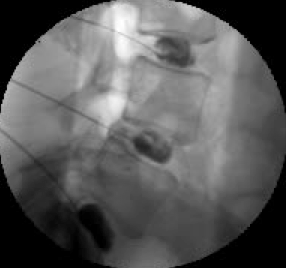What is a Lumbar Discogram?
A discogram is a procedure that is done for diagnostic purposes to see whether or not the intervertebral disc is the source of a patient’s low back pain when degenerative disc disease is present. It is not a therapeutic procedure, as the reason for doing the procedure is to try and temporarily reproduce the pain that the person experiences on a daily basis.
It may help the pain doctor and/or spine surgeon a lot in making decisions for treatment, but really is not in and of itself a therapeutic treatment.
Why is Lumbar Discography Performed?
Individuals who have degenerative disc disease can end up with debilitating low back pain. Degenerative disc disease has been shown to cause significant low back pain in over 30% of those with chronic back pain (Manchikanti et al, Pain Physician 2009). The concern is finding out exactly what is causing the patient’s pain, known as the “pain generator”. For instance, if the patient fails over six months of consecutive nonsurgical treatment, back surgery may be indicated for degenerative disc disease. This may include a spinal fusion or an artificial disc replacement. A lumbar discogram can help determine if in fact an individual’s pain is coming from the degenerative disc being considered for the operation.
Studies performed over the past 20 years have shown that over 40% of people over the age of 40 have evidence of degenerative disease on an MRI (Boden et al). Interestingly, the vast majority of those individuals had no back pain whatsoever! Just because a person has degenerative discs present on MRI does not necessarily mean back pain will be present. This is why lumbar discography is so important, as it can provide evidence of what the disc looks like and receive feedback from the patient during the procedure.
How is a Lumbar Discogram Performed?
A lumbar discogram is performed as an outpatient procedure. Individuals are given IV sedation for the procedure, and they cannot be completely anesthetized because the doctor needs input from the patient. The procedure takes anywhere from 30 to 60 minutes.
During the procedure, sedation is started and the doctor places numbing medicine in the soft tissues all the way down to the spine. A needle is then placed into the disk space being evaluated and injects some fluid under pressure (the fluid has dye in it). The patient is then asked whether not that reproduces the pain he or she has on a daily basis.
Along with the injection into the level of concern, the pain doctor will also do a discogram on one or two adjacent levels. This is called a control and if it reproduces the pain the patient has on a daily basis, then that is concerning. It may cause pain or pressure, but it should not reproduce the daily pain being experienced because it’s not a degenerative level and would not be part of the surgery designed to alleviate that back pain. So if it is positive, it makes it a “confounded” study and difficult to then interpret.
on one or two adjacent levels. This is called a control and if it reproduces the pain the patient has on a daily basis, then that is concerning. It may cause pain or pressure, but it should not reproduce the daily pain being experienced because it’s not a degenerative level and would not be part of the surgery designed to alleviate that back pain. So if it is positive, it makes it a “confounded” study and difficult to then interpret.
How does a Doctor Interpret the Discogram Results?
Once the discogram has been completed, a CT scan is usually obtained to evaluate further the specifics of the degeneration of the disc. The scan shows where exactly the dye that was injected leaked and also whether or not there is degeneration of the joints in the back of the spine.
The report of the discogram indicates two things.
- The subjective findings of how the patient felt with injection of the fluid into the disk space under consideration.
- The objective findings of what happens to the dye with regards to leaking out of the disk space on the imaging studies.
As mentioned, the patient is asked whether or not the injection of fluid reproduces the pain being experienced on a daily basis.
If that is positive, then the assessment is that disc is contributing to the patient’s pain and should be included into whichever treatment is being contemplated.
By looking at the imaging studies performed after the procedure, the doctor can see if dye leaked out of the disk space. When this occurs, it is indicative of tears in the disk and also tells how severe the degeneration is.
Call (602) 507 – 6550 to schedule your Appointment TODAY!

What kind of Research is there on Discography?
There has been a considerable amount of research done on discography over the past few decades. Some of it was done prior to the existence of fluoroscopy (real time x-ray), which brings into question the accuracy of those injections. There are studies that have proven the effectiveness of a discogram in predicting the outcome of surgery, and there are some that have refuted how good it is as a diagnostic procedure. (Regional Anesthesia and Pain Medicine 2005, Cohen et al.)
Therefore, discography is a heavily debated procedure. There are just as many studies showing how great it is as there are studies showing it’s not accurate enough. One study from 2007 concluded that discography is better than MRI for detecting disc ruptures (Garcia et al 2007). A comprehensive review in 2009 showed discography to be accurate if the patient’s pain was reproduced at 7/10 severity (Manchikanti et al, Pain Physician 2009).
One of the heavily debated points of the procedure involves how much pressure is used while inserting the fluid during the procedure. But as of right now it plays an integral role in surgical planning of the lumbar spine, as it is one of the best tools that pain doctors have for deciding whether a particular spinal disc is generating the patient’s pain.
What are the Risks of a Discogram?
The risks of a discogram are small but real. There is a risk of infection, bleeding, nerve injury, and causing pain. An infection in the disc space is called discitis, and the risk is well under 1% with the procedure.
The discogram procedure is not a therapeutic one, and the injection of fluid may spark up some pain that lasts for a few days. Then there are also the usual risks of IV sedation with the procedure.
There has been some basic science research showing the potential for disc degeneration from a discogram procedure. There has not been a large scale study confirming this to date.
Where is a Discogram performed?
Discography is an outpatient procedure, and patients may have it done at a surgery center or in a procedure room in a pain doctors office.

Arizona Pain Specialists offers the Best Pain Management Doctors in Arizona. The doctors are Board Certified and Fellowship Trained, and the practice has won FOUR Patient’s Choice Awards in a Row! They are experts in discogram procedures and the treatment of degenerative disc disease without surgery.
Call (602) 507 – 6550 to schedule your Appointment TODAY!

![]()


 on one or two adjacent levels. This is called a control and if it reproduces the pain the patient has on a daily basis, then that is concerning. It may cause pain or pressure, but it should not reproduce the daily pain being experienced because it’s not a degenerative level and would not be part of the surgery designed to alleviate that back pain. So if it is positive, it makes it a “confounded” study and difficult to then interpret.
on one or two adjacent levels. This is called a control and if it reproduces the pain the patient has on a daily basis, then that is concerning. It may cause pain or pressure, but it should not reproduce the daily pain being experienced because it’s not a degenerative level and would not be part of the surgery designed to alleviate that back pain. So if it is positive, it makes it a “confounded” study and difficult to then interpret.